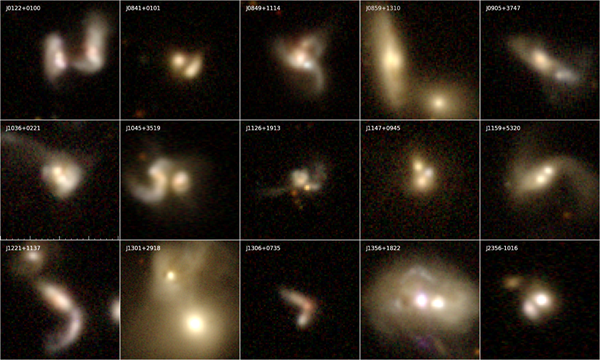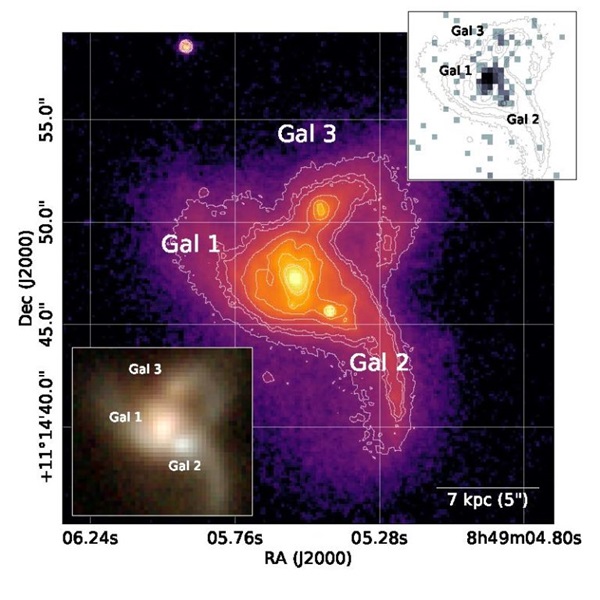Key Takeaways:
On June 28, Ryan Pfeifle of George Mason University presented a set of eight previously unknown dual or triple AGN at the annual meeting of the European Astronomical Society. These are merging galaxies in which the supermassive black holes in each of the participating galaxies are all actively feeding on material from their surroundings. Pfeifle’s team found these pairs and trios using data from NASA’s Wide-Field Infrared Survey Explorer (WISE) telescope and Chandra X-ray Observatory, as well as the European Space Agency’s XMM-Newton X-ray telescope. Their work was published earlier this year in the April 23 edition of The Astrophysical Journal.
Hunting AGN
AGN are most likely to be found in circumstances where there is sufficient “food” available. One such circumstance is during a galaxy merger, when two or more galaxies smash together, a process that disrupts gas, dust and stars, often sending them toward the centers of the galaxies where they can become fodder for the black hole. In some cases, two or more chomping black holes can be spotted as the merger goes through its very last stages.
But this wealth of available food has a catch. Material streaming toward the center of a galaxy feeds the black hole, but it also cloaks the black hole in dense dust and gas. This absorbs optical light from the AGN, making it invisible to optical surveys looking for signs of active black holes. But infrared light can escape as reprocessed light — energy from the AGN that has been absorbed by the dust around it and then re-emitted by those dust grains at longer (infrared) wavelengths.
This is why using WISE was the key to finding these AGN. By searching in infrared light, the team uncovered AGN that would have been missed by other surveys. Pfeifle’s team selected objects that looked like AGN in the infrared data, then followed up by observing them in X-ray light, too. X-rays can shoot straight through gas and dust, and are a clear sign of a feeding black hole. By matching the two samples, the team could even determine whether the X-rays seemed to be coming from one or more sources: single, dual, or triple AGN.
Twos and threes
Dual AGN are rare, and triple systems are rarer. This leads astronomers to ask why that might be. Maybe they’re just hard to spot, or maybe they don’t last very long. Maybe they really are just rare, and special circumstances are needed to get two or more supermassive black holes actively feeding during a merger. Learning the answer would tell astronomers a lot about how galaxies evolve, because mergers are one of the major ways in which galaxies grow and age, and they probably happen to most galaxies once or more throughout their lifetimes.
Also important is the fact that dual AGN are the precursors of supermassive black hole mergers, which, like smaller stellar-mass black hole mergers, produce gravitational waves that could be detected by the gravitational wave observatories now scanning the skies.
Two mergers in the sample, SDSS J130653.60+073518.1 and SDSS J084905.51+111447.2 (J1306+0735 and J084+1114 for short, respectively), are triple AGN candidates, meaning the team spotted X-rays coming from three separate sources as three galaxies come together. Triple AGN are even more interesting for gravitational-wave researchers, because three AGN circling each other make it more likely that at least two of those AGN will merge sooner than they would have if there were only two.
Triple systems also increase the chances that one of the AGN could end up kicked out of the galaxy altogether — a rare sight, but one astronomers have spotted before.
In a press release Pfeifle said the study shows the power of looking in infrared light for multiple AGN that are completely invisible to optical telescopes. Additionally, he said, the same technique will help astronomers find more triple AGN to learn how likely these systems are to occur and what they can teach us about our universe.

Are you ready to learn more about AGN? Check out this feature from the pages of Astronomy: Glimpsing the hearts of galaxies.











